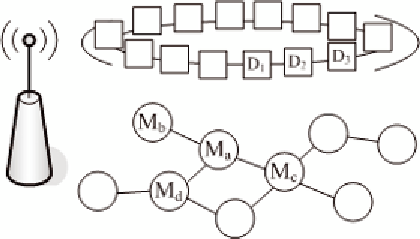Information Technology Reference
In-Depth Information
from traditional point-to-point access in that the
broadcast channel is open to all mobile clients and
one transmission of a data object on the broadcast
channel can satisfy the needs of potentially many
clients. Mobile broadcast is especially suitable for
data dissemination in asymmetric communication
environments where the client to server ratio is
large and there is a high degree of commonality
among client interests. Information interesting
to the majority of the clients is more suitable for
broadcast. Many projects and systems are based
on the data broadcast technology (Acharya &
Franklin, 1995; Acharya, 1997; Acharya, 1998;
Altinel, 1999; Hughes, 2008; Gifford, 1990;
Imielinski, 1997; Microsoft, 2008; Zheng, 2005).
They are sometimes referred to in the literature
as Dissemination-Based Information Systems
(DBIS) (Franklin, 1996).
Mobile peers in broadcast environments some-
times suffer from long access latency (the time
elapsed from the moment a client has a query for
a data object to the point when the client gets the
data object), especially when the broadcast cycle
is long due to large volume of data or limited
broadcast channel. When the broadcast cycle
is long, a mobile peer has to wait a long time
before their required data objects appear on the
broadcast channel.
Caching and prefetching are two effective
ways to improve response time. They both store
copies of data objects locally for future use. The
difference is that caching happens after data ac-
cess while prefetching stores data objects that
are not currently under demand but believed to
be useful in the future. In other words, caching
is driven by data accesses, and prefetching is
driven by anticipation of future accesses. In the
environments of mobile broadcast, caching is
the mechanism used to store a data object after
it is taken from the broadcast channel to fulfill
a pending request, and prefetching is to actively
listen to the broadcast channel to grab objects that
are anticipated to be useful. Thus in prefetching
the mobile peer listens to the broadcast channel
even when there is no pending request and stores
interesting objects locally. A carefully designed
prefetching scheme results in better access latency
than a caching scheme does, while consuming
more energy (Acharya, 1996).
The fact that the mobile peers have small local
storage space limits the effectiveness of caching
and prefetching. Local storage constraint makes
it impossible to hold all interesting data objects
that may be accessed.
With short-range wireless communication
technologies, such as IEEE802.11 and Bluetooth,
a mobile peer is able to communicate with other
mobile peers in its communication range. Figure
1 is an illustration of cooperative mobile peers in
a mobile broadcast environment. A line between
two mobile peers means they can communicate
directly and share contents in a simple peer-to-peer
fashion. This enables the mobile peers to share
cached or prefetched data objects: when a mobile
peer needs a data object, it can request it from its
neighbors (we define a mobile peer's neighbors as
the mobile peers within its communication range,
i.e. one hop away). Such cooperation improves
applications' response time, because a mobile
peer now can probably get its required data ob-
ject from its neighbors before getting it on the
broadcast channel. This may even reduce energy
consumption because getting a data object from
Figure 1. Cooperation among mobile peers. A line
between two peers means they can communicate
directly and share contents in a simple peer-to-
peer fashion

Search WWH ::

Custom Search